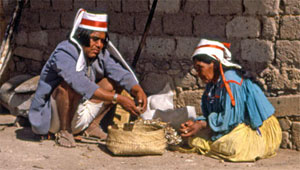
Anthropologist Carl Lumholtz predicted that the Tarahumara Indians would disappear within a century. A hundred years later, these gentle people, who inhabit Mexico’s Copper Canyon, continue to be the most populous indigenous group in northern Mexico.
Spanish explorers had entered the Sierra Madre Mountains by the mid-16th century. Gold and silver were soon discovered and mines began operating. The Indians were pressed into the labor force, often enduring the harshest conditions.
The Jesuits established their first mission pueblo in 1611. Although many attempted to ease the burden of the Indians, a great deal of prejudice existed. An early Jesuit wrote, “They are inclined to idleness, drunkenness and other vices. They are ungrateful, dull and stupid…very cunning and alert in evil things…They have no sense of personal honor nor the honor of their daughters.”
Forced to live in artificially-created communities, the Indians were susceptible to a variety of diseases, and epidemics swept the area. As the demand for labor increased, the Spanish raided the mission pueblos. The Jesuits managed to protect some of their charges, but many Tarahumara fled, hiding deep in Copper Canyon. The expulsion of the Jesuits from the Americas, in 1767, ended their efforts to protect the Indians, and the Franciscans, who succeeded them, were not as effective.
Mexico attained independence in 1821 and soon established huge land grants in Tarahumara country. The Indians were uprooted again, and fled, often onto lands of other indigenous people. Fighting often resulted.
The Revolution of 1910-21 resulted in the re-creation of the pre-hispanic communal landholding system known as the ejido. The Tarahumara received some benefits from this, as much of this land has economic potential for lumbering, agriculture, and tourism. Around 60,000 Tarahumara still inhabit caves and simple dwellings in Copper Canyon.
The California Native has for many years assisted these people, donating clothing, school supplies and money. Some of our travelers have returned to volunteer in local clinics. Tourism is a positive factor, and visitors gain a new appreciation for these noble people who have survived and thrived despite Lumholtz’ dire predictions.
